Analyzing Consumer Behavior and Decision Making for Coca-Cola
VerifiedAdded on 2020/06/04
|11
|2621
|341
Report
AI Summary
This report delves into the realm of consumer behavior, specifically examining the context of Coca-Cola products. It initiates with an introduction to consumer purchase behavior, defining it and highlighting its relevance to Coca-Cola. The report then constructs a consumer decision-making model, breaking down the process into key stages such as need recognition, information search, evaluation of alternatives, purchase decision, and post-purchase evaluation. It explores the factors that influence consumer decision-making, including heuristics, marketing mix elements, and the impact of new technologies. The report also emphasizes the importance for marketers to understand consumer behavior to maintain a competitive edge. Furthermore, it differentiates between B2B and B2C marketing strategies, analyzing how marketers influence each stage of the consumer decision-making process in both contexts, and concludes with the impact of consumer behavior on an organization's profitability.
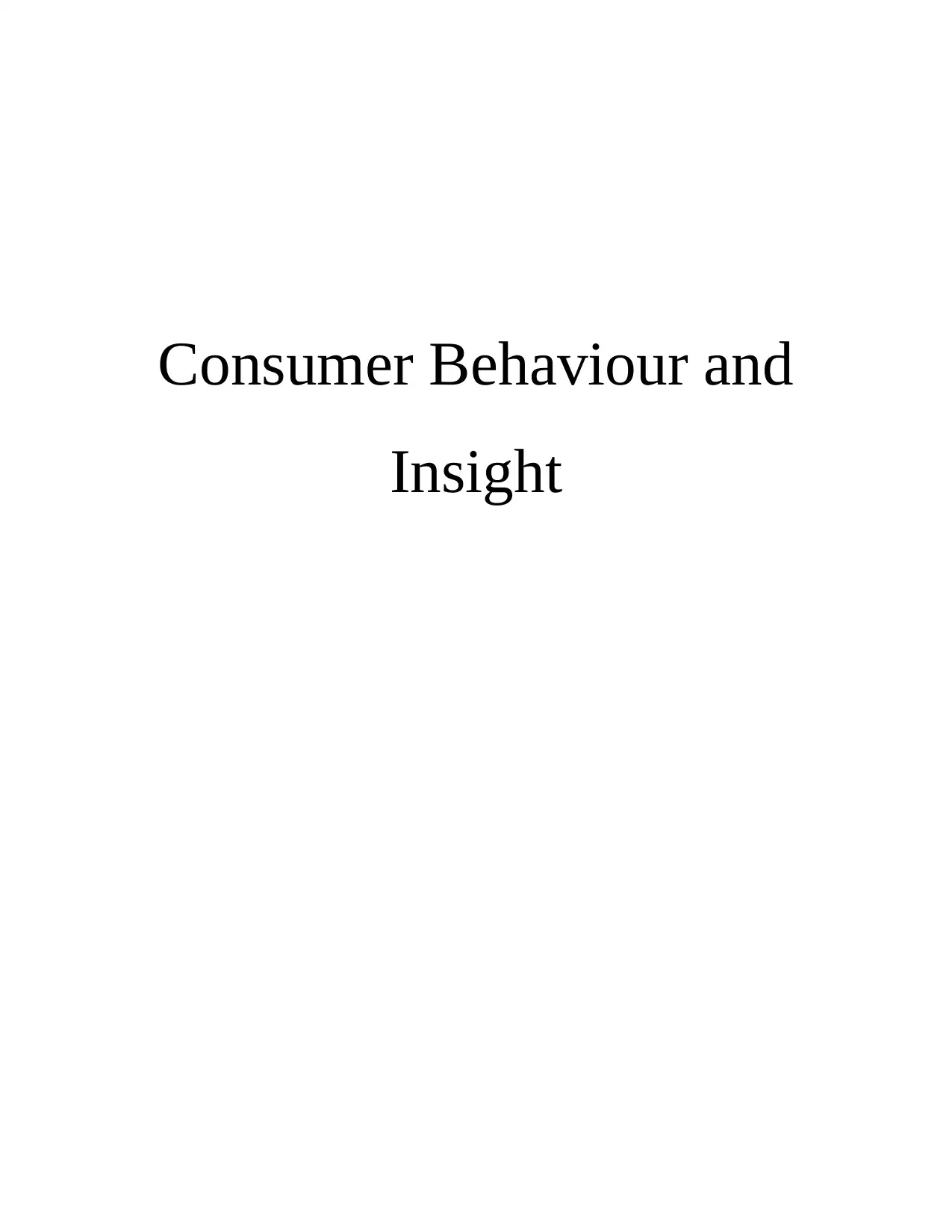
Consumer Behaviour and
Insight
Insight
Paraphrase This Document
Need a fresh take? Get an instant paraphrase of this document with our AI Paraphraser
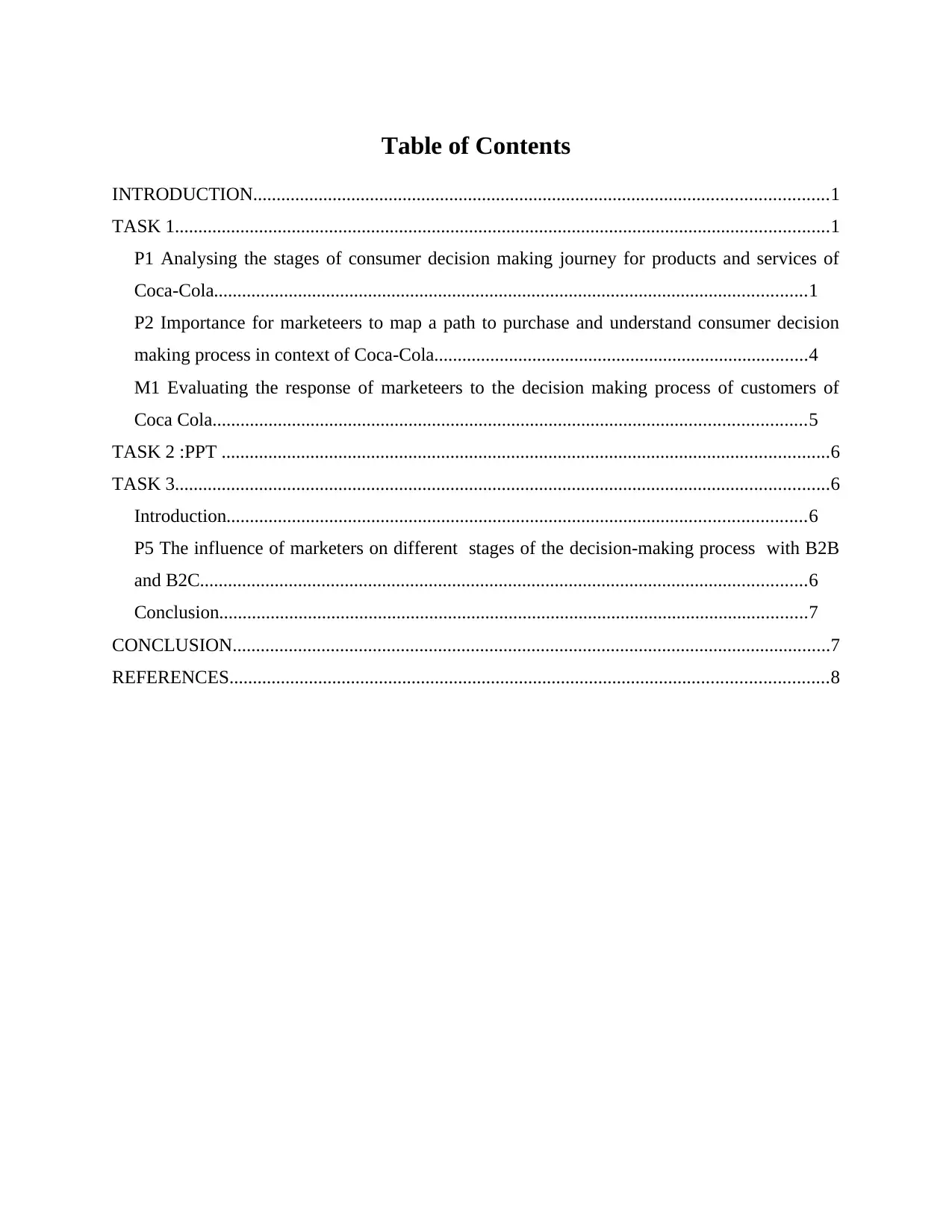
Table of Contents
INTRODUCTION...........................................................................................................................1
TASK 1............................................................................................................................................1
P1 Analysing the stages of consumer decision making journey for products and services of
Coca-Cola...............................................................................................................................1
P2 Importance for marketeers to map a path to purchase and understand consumer decision
making process in context of Coca-Cola................................................................................4
M1 Evaluating the response of marketeers to the decision making process of customers of
Coca Cola...............................................................................................................................5
TASK 2 :PPT ..................................................................................................................................6
TASK 3............................................................................................................................................6
Introduction............................................................................................................................6
P5 The influence of marketers on different stages of the decision-making process with B2B
and B2C..................................................................................................................................6
Conclusion..............................................................................................................................7
CONCLUSION................................................................................................................................7
REFERENCES................................................................................................................................8
INTRODUCTION...........................................................................................................................1
TASK 1............................................................................................................................................1
P1 Analysing the stages of consumer decision making journey for products and services of
Coca-Cola...............................................................................................................................1
P2 Importance for marketeers to map a path to purchase and understand consumer decision
making process in context of Coca-Cola................................................................................4
M1 Evaluating the response of marketeers to the decision making process of customers of
Coca Cola...............................................................................................................................5
TASK 2 :PPT ..................................................................................................................................6
TASK 3............................................................................................................................................6
Introduction............................................................................................................................6
P5 The influence of marketers on different stages of the decision-making process with B2B
and B2C..................................................................................................................................6
Conclusion..............................................................................................................................7
CONCLUSION................................................................................................................................7
REFERENCES................................................................................................................................8
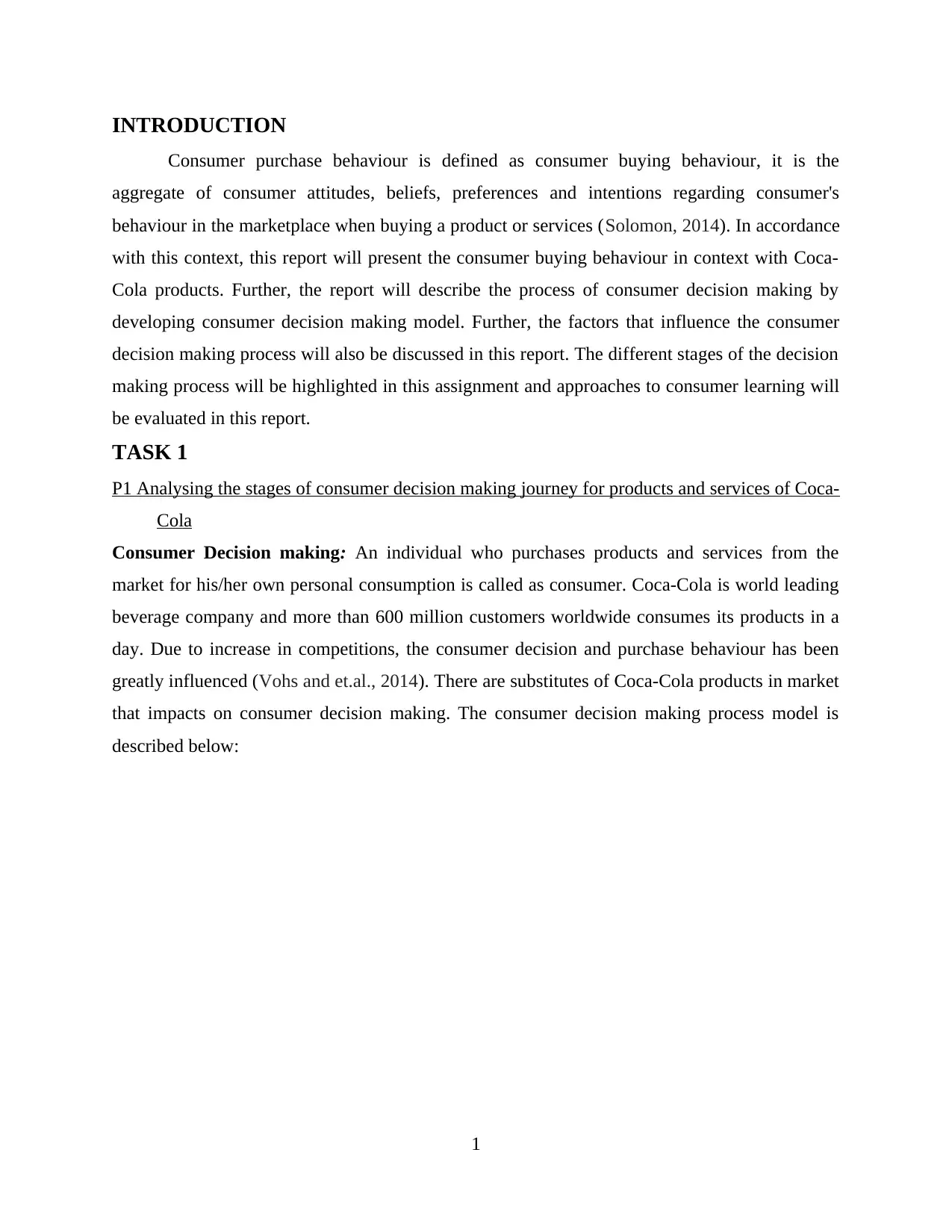
INTRODUCTION
Consumer purchase behaviour is defined as consumer buying behaviour, it is the
aggregate of consumer attitudes, beliefs, preferences and intentions regarding consumer's
behaviour in the marketplace when buying a product or services (Solomon, 2014). In accordance
with this context, this report will present the consumer buying behaviour in context with Coca-
Cola products. Further, the report will describe the process of consumer decision making by
developing consumer decision making model. Further, the factors that influence the consumer
decision making process will also be discussed in this report. The different stages of the decision
making process will be highlighted in this assignment and approaches to consumer learning will
be evaluated in this report.
TASK 1
P1 Analysing the stages of consumer decision making journey for products and services of Coca-
Cola
Consumer Decision making: An individual who purchases products and services from the
market for his/her own personal consumption is called as consumer. Coca-Cola is world leading
beverage company and more than 600 million customers worldwide consumes its products in a
day. Due to increase in competitions, the consumer decision and purchase behaviour has been
greatly influenced (Vohs and et.al., 2014). There are substitutes of Coca-Cola products in market
that impacts on consumer decision making. The consumer decision making process model is
described below:
1
Consumer purchase behaviour is defined as consumer buying behaviour, it is the
aggregate of consumer attitudes, beliefs, preferences and intentions regarding consumer's
behaviour in the marketplace when buying a product or services (Solomon, 2014). In accordance
with this context, this report will present the consumer buying behaviour in context with Coca-
Cola products. Further, the report will describe the process of consumer decision making by
developing consumer decision making model. Further, the factors that influence the consumer
decision making process will also be discussed in this report. The different stages of the decision
making process will be highlighted in this assignment and approaches to consumer learning will
be evaluated in this report.
TASK 1
P1 Analysing the stages of consumer decision making journey for products and services of Coca-
Cola
Consumer Decision making: An individual who purchases products and services from the
market for his/her own personal consumption is called as consumer. Coca-Cola is world leading
beverage company and more than 600 million customers worldwide consumes its products in a
day. Due to increase in competitions, the consumer decision and purchase behaviour has been
greatly influenced (Vohs and et.al., 2014). There are substitutes of Coca-Cola products in market
that impacts on consumer decision making. The consumer decision making process model is
described below:
1
⊘ This is a preview!⊘
Do you want full access?
Subscribe today to unlock all pages.

Trusted by 1+ million students worldwide
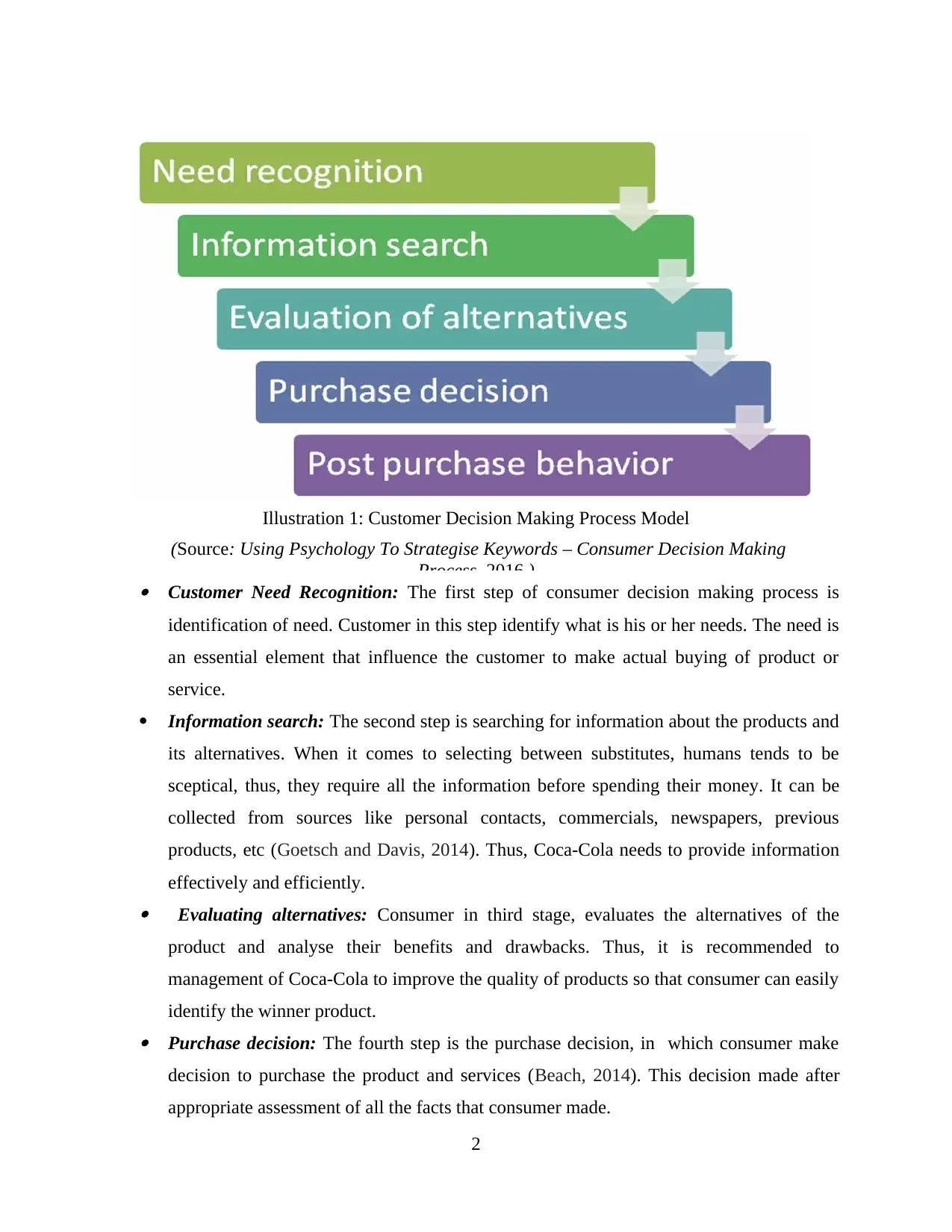
Customer Need Recognition: The first step of consumer decision making process is
identification of need. Customer in this step identify what is his or her needs. The need is
an essential element that influence the customer to make actual buying of product or
service.
Information search: The second step is searching for information about the products and
its alternatives. When it comes to selecting between substitutes, humans tends to be
sceptical, thus, they require all the information before spending their money. It can be
collected from sources like personal contacts, commercials, newspapers, previous
products, etc (Goetsch and Davis, 2014). Thus, Coca-Cola needs to provide information
effectively and efficiently. Evaluating alternatives: Consumer in third stage, evaluates the alternatives of the
product and analyse their benefits and drawbacks. Thus, it is recommended to
management of Coca-Cola to improve the quality of products so that consumer can easily
identify the winner product. Purchase decision: The fourth step is the purchase decision, in which consumer make
decision to purchase the product and services (Beach, 2014). This decision made after
appropriate assessment of all the facts that consumer made.
2
Illustration 1: Customer Decision Making Process Model
(Source: Using Psychology To Strategise Keywords – Consumer Decision Making
Process, 2016 )
identification of need. Customer in this step identify what is his or her needs. The need is
an essential element that influence the customer to make actual buying of product or
service.
Information search: The second step is searching for information about the products and
its alternatives. When it comes to selecting between substitutes, humans tends to be
sceptical, thus, they require all the information before spending their money. It can be
collected from sources like personal contacts, commercials, newspapers, previous
products, etc (Goetsch and Davis, 2014). Thus, Coca-Cola needs to provide information
effectively and efficiently. Evaluating alternatives: Consumer in third stage, evaluates the alternatives of the
product and analyse their benefits and drawbacks. Thus, it is recommended to
management of Coca-Cola to improve the quality of products so that consumer can easily
identify the winner product. Purchase decision: The fourth step is the purchase decision, in which consumer make
decision to purchase the product and services (Beach, 2014). This decision made after
appropriate assessment of all the facts that consumer made.
2
Illustration 1: Customer Decision Making Process Model
(Source: Using Psychology To Strategise Keywords – Consumer Decision Making
Process, 2016 )
Paraphrase This Document
Need a fresh take? Get an instant paraphrase of this document with our AI Paraphraser
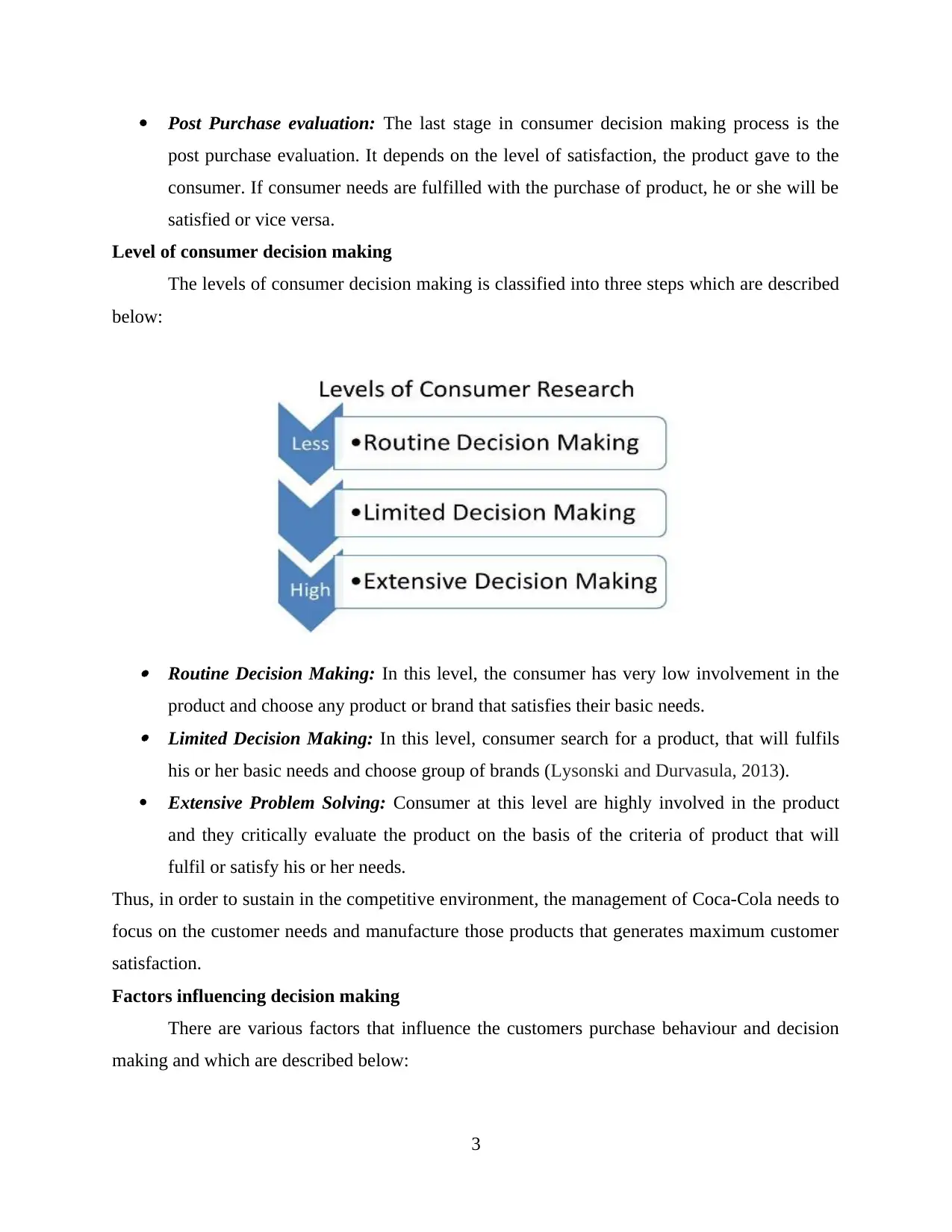
Post Purchase evaluation: The last stage in consumer decision making process is the
post purchase evaluation. It depends on the level of satisfaction, the product gave to the
consumer. If consumer needs are fulfilled with the purchase of product, he or she will be
satisfied or vice versa.
Level of consumer decision making
The levels of consumer decision making is classified into three steps which are described
below:
Routine Decision Making: In this level, the consumer has very low involvement in the
product and choose any product or brand that satisfies their basic needs. Limited Decision Making: In this level, consumer search for a product, that will fulfils
his or her basic needs and choose group of brands (Lysonski and Durvasula, 2013).
Extensive Problem Solving: Consumer at this level are highly involved in the product
and they critically evaluate the product on the basis of the criteria of product that will
fulfil or satisfy his or her needs.
Thus, in order to sustain in the competitive environment, the management of Coca-Cola needs to
focus on the customer needs and manufacture those products that generates maximum customer
satisfaction.
Factors influencing decision making
There are various factors that influence the customers purchase behaviour and decision
making and which are described below:
3
post purchase evaluation. It depends on the level of satisfaction, the product gave to the
consumer. If consumer needs are fulfilled with the purchase of product, he or she will be
satisfied or vice versa.
Level of consumer decision making
The levels of consumer decision making is classified into three steps which are described
below:
Routine Decision Making: In this level, the consumer has very low involvement in the
product and choose any product or brand that satisfies their basic needs. Limited Decision Making: In this level, consumer search for a product, that will fulfils
his or her basic needs and choose group of brands (Lysonski and Durvasula, 2013).
Extensive Problem Solving: Consumer at this level are highly involved in the product
and they critically evaluate the product on the basis of the criteria of product that will
fulfil or satisfy his or her needs.
Thus, in order to sustain in the competitive environment, the management of Coca-Cola needs to
focus on the customer needs and manufacture those products that generates maximum customer
satisfaction.
Factors influencing decision making
There are various factors that influence the customers purchase behaviour and decision
making and which are described below:
3
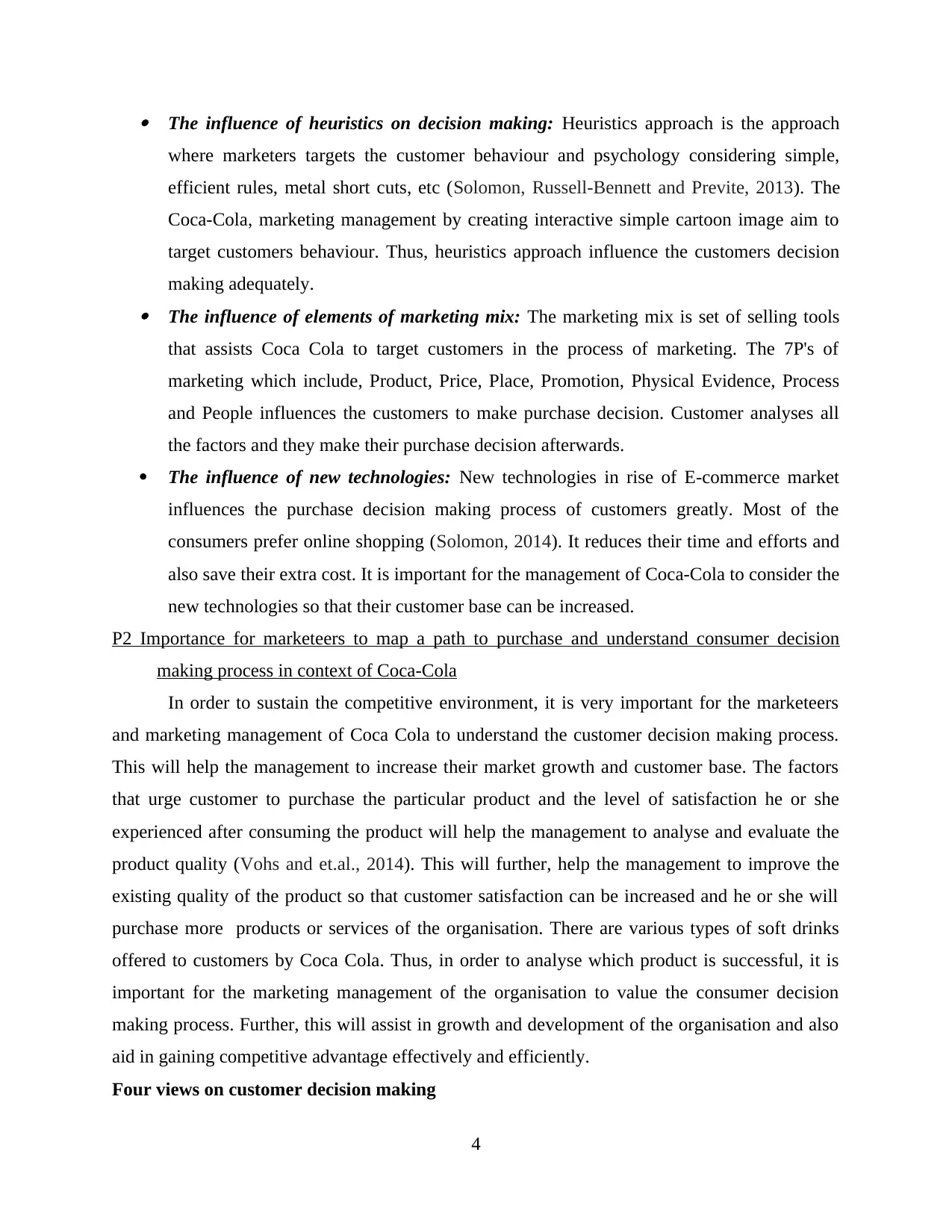
The influence of heuristics on decision making: Heuristics approach is the approach
where marketers targets the customer behaviour and psychology considering simple,
efficient rules, metal short cuts, etc (Solomon, Russell-Bennett and Previte, 2013). The
Coca-Cola, marketing management by creating interactive simple cartoon image aim to
target customers behaviour. Thus, heuristics approach influence the customers decision
making adequately. The influence of elements of marketing mix: The marketing mix is set of selling tools
that assists Coca Cola to target customers in the process of marketing. The 7P's of
marketing which include, Product, Price, Place, Promotion, Physical Evidence, Process
and People influences the customers to make purchase decision. Customer analyses all
the factors and they make their purchase decision afterwards.
The influence of new technologies: New technologies in rise of E-commerce market
influences the purchase decision making process of customers greatly. Most of the
consumers prefer online shopping (Solomon, 2014). It reduces their time and efforts and
also save their extra cost. It is important for the management of Coca-Cola to consider the
new technologies so that their customer base can be increased.
P2 Importance for marketeers to map a path to purchase and understand consumer decision
making process in context of Coca-Cola
In order to sustain the competitive environment, it is very important for the marketeers
and marketing management of Coca Cola to understand the customer decision making process.
This will help the management to increase their market growth and customer base. The factors
that urge customer to purchase the particular product and the level of satisfaction he or she
experienced after consuming the product will help the management to analyse and evaluate the
product quality (Vohs and et.al., 2014). This will further, help the management to improve the
existing quality of the product so that customer satisfaction can be increased and he or she will
purchase more products or services of the organisation. There are various types of soft drinks
offered to customers by Coca Cola. Thus, in order to analyse which product is successful, it is
important for the marketing management of the organisation to value the consumer decision
making process. Further, this will assist in growth and development of the organisation and also
aid in gaining competitive advantage effectively and efficiently.
Four views on customer decision making
4
where marketers targets the customer behaviour and psychology considering simple,
efficient rules, metal short cuts, etc (Solomon, Russell-Bennett and Previte, 2013). The
Coca-Cola, marketing management by creating interactive simple cartoon image aim to
target customers behaviour. Thus, heuristics approach influence the customers decision
making adequately. The influence of elements of marketing mix: The marketing mix is set of selling tools
that assists Coca Cola to target customers in the process of marketing. The 7P's of
marketing which include, Product, Price, Place, Promotion, Physical Evidence, Process
and People influences the customers to make purchase decision. Customer analyses all
the factors and they make their purchase decision afterwards.
The influence of new technologies: New technologies in rise of E-commerce market
influences the purchase decision making process of customers greatly. Most of the
consumers prefer online shopping (Solomon, 2014). It reduces their time and efforts and
also save their extra cost. It is important for the management of Coca-Cola to consider the
new technologies so that their customer base can be increased.
P2 Importance for marketeers to map a path to purchase and understand consumer decision
making process in context of Coca-Cola
In order to sustain the competitive environment, it is very important for the marketeers
and marketing management of Coca Cola to understand the customer decision making process.
This will help the management to increase their market growth and customer base. The factors
that urge customer to purchase the particular product and the level of satisfaction he or she
experienced after consuming the product will help the management to analyse and evaluate the
product quality (Vohs and et.al., 2014). This will further, help the management to improve the
existing quality of the product so that customer satisfaction can be increased and he or she will
purchase more products or services of the organisation. There are various types of soft drinks
offered to customers by Coca Cola. Thus, in order to analyse which product is successful, it is
important for the marketing management of the organisation to value the consumer decision
making process. Further, this will assist in growth and development of the organisation and also
aid in gaining competitive advantage effectively and efficiently.
Four views on customer decision making
4
⊘ This is a preview!⊘
Do you want full access?
Subscribe today to unlock all pages.

Trusted by 1+ million students worldwide
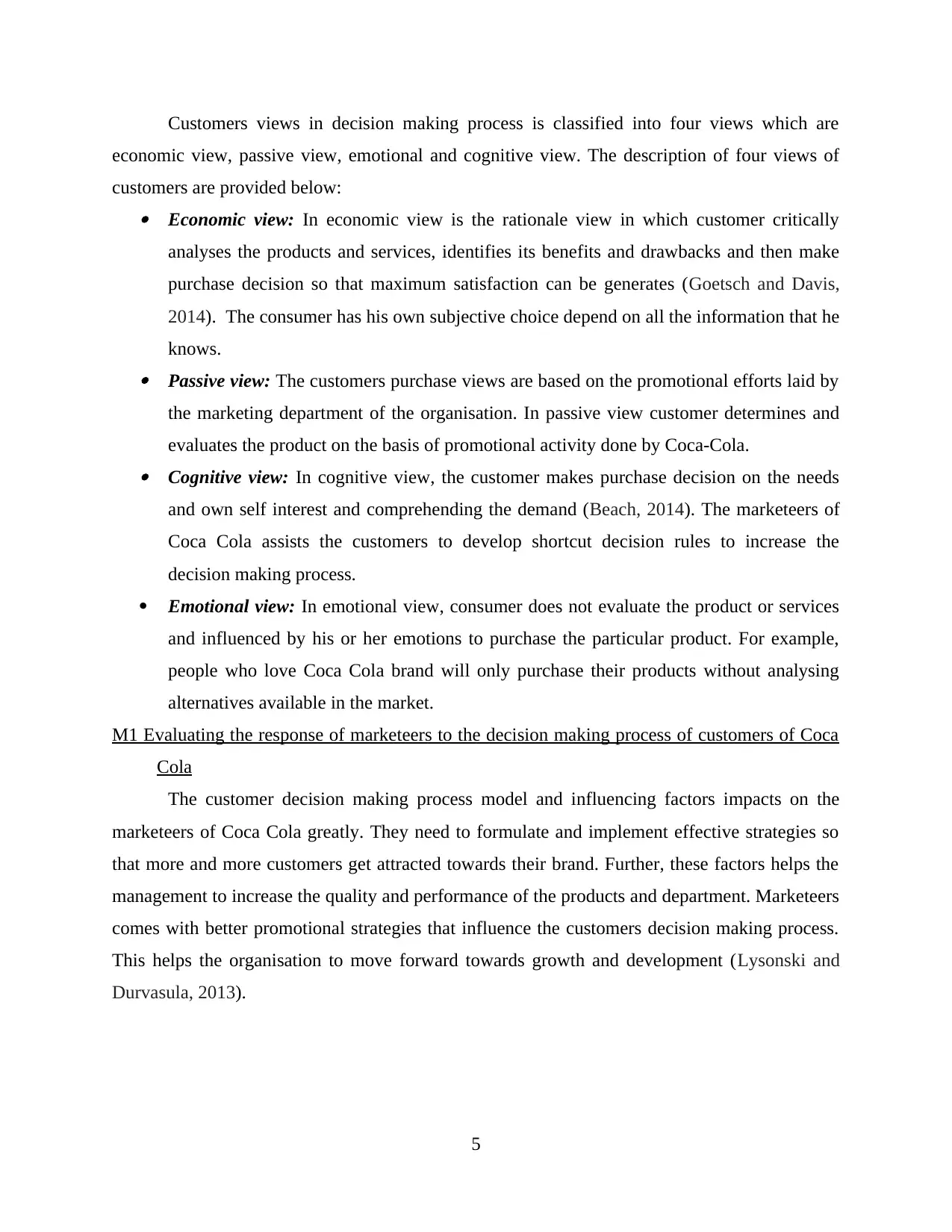
Customers views in decision making process is classified into four views which are
economic view, passive view, emotional and cognitive view. The description of four views of
customers are provided below: Economic view: In economic view is the rationale view in which customer critically
analyses the products and services, identifies its benefits and drawbacks and then make
purchase decision so that maximum satisfaction can be generates (Goetsch and Davis,
2014). The consumer has his own subjective choice depend on all the information that he
knows. Passive view: The customers purchase views are based on the promotional efforts laid by
the marketing department of the organisation. In passive view customer determines and
evaluates the product on the basis of promotional activity done by Coca-Cola. Cognitive view: In cognitive view, the customer makes purchase decision on the needs
and own self interest and comprehending the demand (Beach, 2014). The marketeers of
Coca Cola assists the customers to develop shortcut decision rules to increase the
decision making process.
Emotional view: In emotional view, consumer does not evaluate the product or services
and influenced by his or her emotions to purchase the particular product. For example,
people who love Coca Cola brand will only purchase their products without analysing
alternatives available in the market.
M1 Evaluating the response of marketeers to the decision making process of customers of Coca
Cola
The customer decision making process model and influencing factors impacts on the
marketeers of Coca Cola greatly. They need to formulate and implement effective strategies so
that more and more customers get attracted towards their brand. Further, these factors helps the
management to increase the quality and performance of the products and department. Marketeers
comes with better promotional strategies that influence the customers decision making process.
This helps the organisation to move forward towards growth and development (Lysonski and
Durvasula, 2013).
5
economic view, passive view, emotional and cognitive view. The description of four views of
customers are provided below: Economic view: In economic view is the rationale view in which customer critically
analyses the products and services, identifies its benefits and drawbacks and then make
purchase decision so that maximum satisfaction can be generates (Goetsch and Davis,
2014). The consumer has his own subjective choice depend on all the information that he
knows. Passive view: The customers purchase views are based on the promotional efforts laid by
the marketing department of the organisation. In passive view customer determines and
evaluates the product on the basis of promotional activity done by Coca-Cola. Cognitive view: In cognitive view, the customer makes purchase decision on the needs
and own self interest and comprehending the demand (Beach, 2014). The marketeers of
Coca Cola assists the customers to develop shortcut decision rules to increase the
decision making process.
Emotional view: In emotional view, consumer does not evaluate the product or services
and influenced by his or her emotions to purchase the particular product. For example,
people who love Coca Cola brand will only purchase their products without analysing
alternatives available in the market.
M1 Evaluating the response of marketeers to the decision making process of customers of Coca
Cola
The customer decision making process model and influencing factors impacts on the
marketeers of Coca Cola greatly. They need to formulate and implement effective strategies so
that more and more customers get attracted towards their brand. Further, these factors helps the
management to increase the quality and performance of the products and department. Marketeers
comes with better promotional strategies that influence the customers decision making process.
This helps the organisation to move forward towards growth and development (Lysonski and
Durvasula, 2013).
5
Paraphrase This Document
Need a fresh take? Get an instant paraphrase of this document with our AI Paraphraser
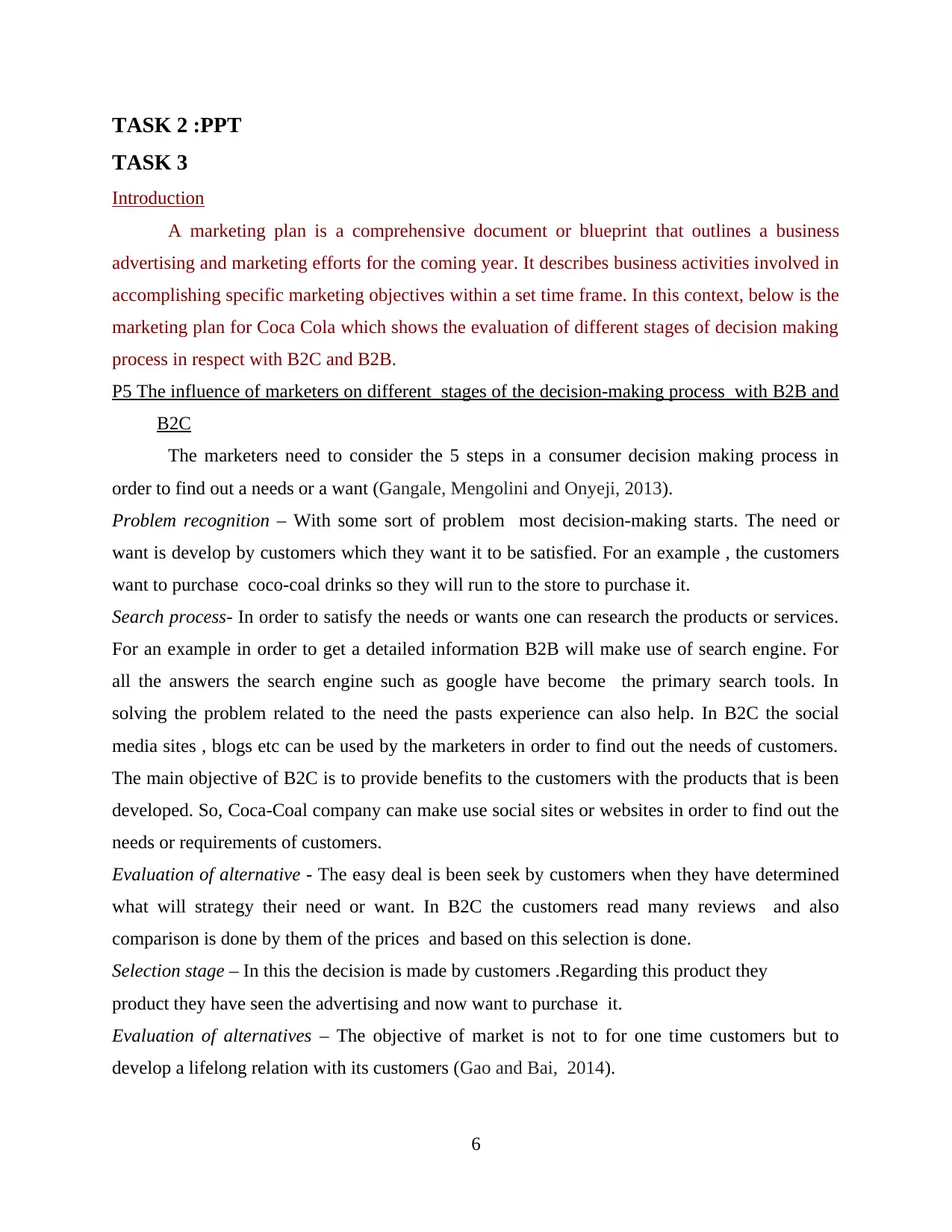
TASK 2 :PPT
TASK 3
Introduction
A marketing plan is a comprehensive document or blueprint that outlines a business
advertising and marketing efforts for the coming year. It describes business activities involved in
accomplishing specific marketing objectives within a set time frame. In this context, below is the
marketing plan for Coca Cola which shows the evaluation of different stages of decision making
process in respect with B2C and B2B.
P5 The influence of marketers on different stages of the decision-making process with B2B and
B2C
The marketers need to consider the 5 steps in a consumer decision making process in
order to find out a needs or a want (Gangale, Mengolini and Onyeji, 2013).
Problem recognition – With some sort of problem most decision-making starts. The need or
want is develop by customers which they want it to be satisfied. For an example , the customers
want to purchase coco-coal drinks so they will run to the store to purchase it.
Search process- In order to satisfy the needs or wants one can research the products or services.
For an example in order to get a detailed information B2B will make use of search engine. For
all the answers the search engine such as google have become the primary search tools. In
solving the problem related to the need the pasts experience can also help. In B2C the social
media sites , blogs etc can be used by the marketers in order to find out the needs of customers.
The main objective of B2C is to provide benefits to the customers with the products that is been
developed. So, Coca-Coal company can make use social sites or websites in order to find out the
needs or requirements of customers.
Evaluation of alternative - The easy deal is been seek by customers when they have determined
what will strategy their need or want. In B2C the customers read many reviews and also
comparison is done by them of the prices and based on this selection is done.
Selection stage – In this the decision is made by customers .Regarding this product they
product they have seen the advertising and now want to purchase it.
Evaluation of alternatives – The objective of market is not to for one time customers but to
develop a lifelong relation with its customers (Gao and Bai, 2014).
6
TASK 3
Introduction
A marketing plan is a comprehensive document or blueprint that outlines a business
advertising and marketing efforts for the coming year. It describes business activities involved in
accomplishing specific marketing objectives within a set time frame. In this context, below is the
marketing plan for Coca Cola which shows the evaluation of different stages of decision making
process in respect with B2C and B2B.
P5 The influence of marketers on different stages of the decision-making process with B2B and
B2C
The marketers need to consider the 5 steps in a consumer decision making process in
order to find out a needs or a want (Gangale, Mengolini and Onyeji, 2013).
Problem recognition – With some sort of problem most decision-making starts. The need or
want is develop by customers which they want it to be satisfied. For an example , the customers
want to purchase coco-coal drinks so they will run to the store to purchase it.
Search process- In order to satisfy the needs or wants one can research the products or services.
For an example in order to get a detailed information B2B will make use of search engine. For
all the answers the search engine such as google have become the primary search tools. In
solving the problem related to the need the pasts experience can also help. In B2C the social
media sites , blogs etc can be used by the marketers in order to find out the needs of customers.
The main objective of B2C is to provide benefits to the customers with the products that is been
developed. So, Coca-Coal company can make use social sites or websites in order to find out the
needs or requirements of customers.
Evaluation of alternative - The easy deal is been seek by customers when they have determined
what will strategy their need or want. In B2C the customers read many reviews and also
comparison is done by them of the prices and based on this selection is done.
Selection stage – In this the decision is made by customers .Regarding this product they
product they have seen the advertising and now want to purchase it.
Evaluation of alternatives – The objective of market is not to for one time customers but to
develop a lifelong relation with its customers (Gao and Bai, 2014).
6
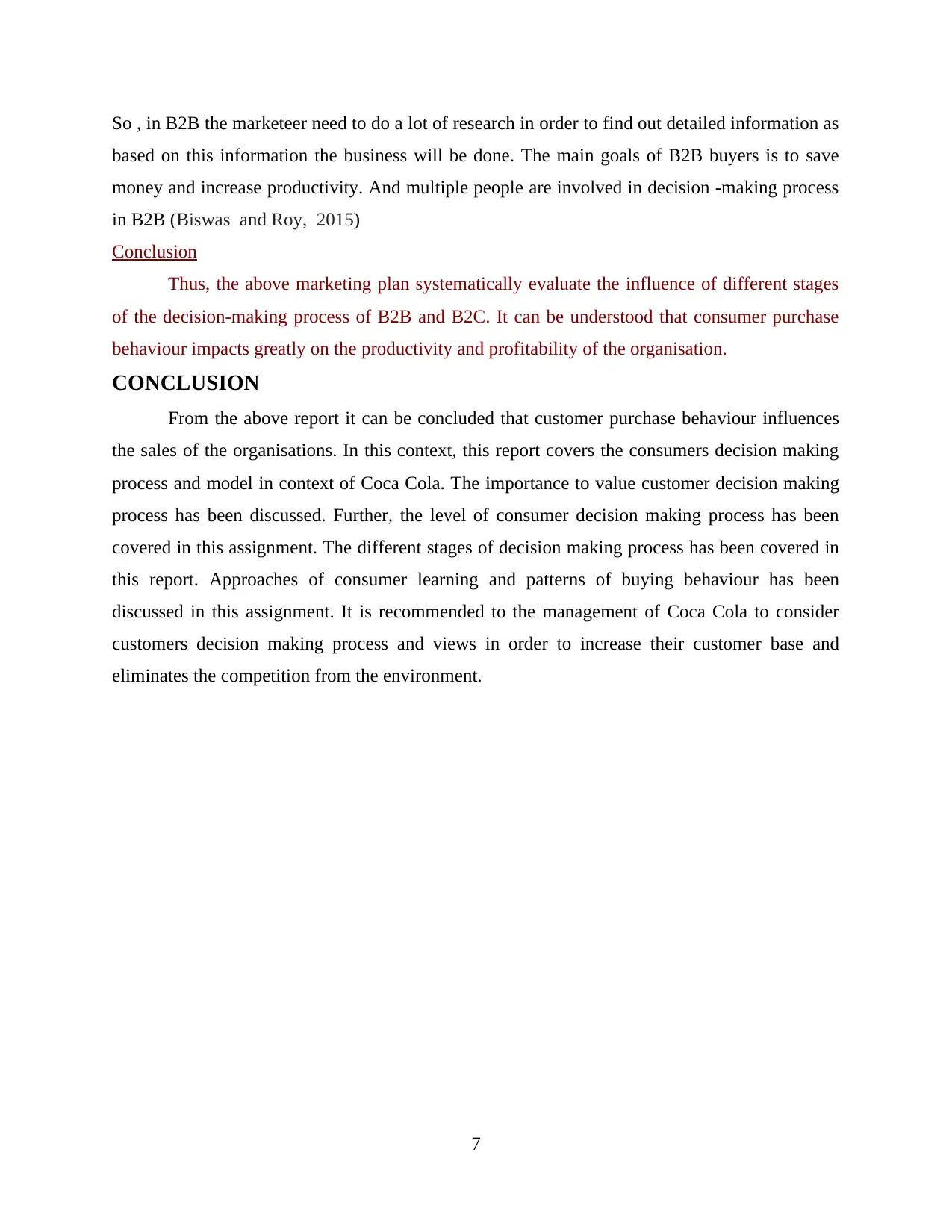
So , in B2B the marketeer need to do a lot of research in order to find out detailed information as
based on this information the business will be done. The main goals of B2B buyers is to save
money and increase productivity. And multiple people are involved in decision -making process
in B2B (Biswas and Roy, 2015)
Conclusion
Thus, the above marketing plan systematically evaluate the influence of different stages
of the decision-making process of B2B and B2C. It can be understood that consumer purchase
behaviour impacts greatly on the productivity and profitability of the organisation.
CONCLUSION
From the above report it can be concluded that customer purchase behaviour influences
the sales of the organisations. In this context, this report covers the consumers decision making
process and model in context of Coca Cola. The importance to value customer decision making
process has been discussed. Further, the level of consumer decision making process has been
covered in this assignment. The different stages of decision making process has been covered in
this report. Approaches of consumer learning and patterns of buying behaviour has been
discussed in this assignment. It is recommended to the management of Coca Cola to consider
customers decision making process and views in order to increase their customer base and
eliminates the competition from the environment.
7
based on this information the business will be done. The main goals of B2B buyers is to save
money and increase productivity. And multiple people are involved in decision -making process
in B2B (Biswas and Roy, 2015)
Conclusion
Thus, the above marketing plan systematically evaluate the influence of different stages
of the decision-making process of B2B and B2C. It can be understood that consumer purchase
behaviour impacts greatly on the productivity and profitability of the organisation.
CONCLUSION
From the above report it can be concluded that customer purchase behaviour influences
the sales of the organisations. In this context, this report covers the consumers decision making
process and model in context of Coca Cola. The importance to value customer decision making
process has been discussed. Further, the level of consumer decision making process has been
covered in this assignment. The different stages of decision making process has been covered in
this report. Approaches of consumer learning and patterns of buying behaviour has been
discussed in this assignment. It is recommended to the management of Coca Cola to consider
customers decision making process and views in order to increase their customer base and
eliminates the competition from the environment.
7
⊘ This is a preview!⊘
Do you want full access?
Subscribe today to unlock all pages.

Trusted by 1+ million students worldwide
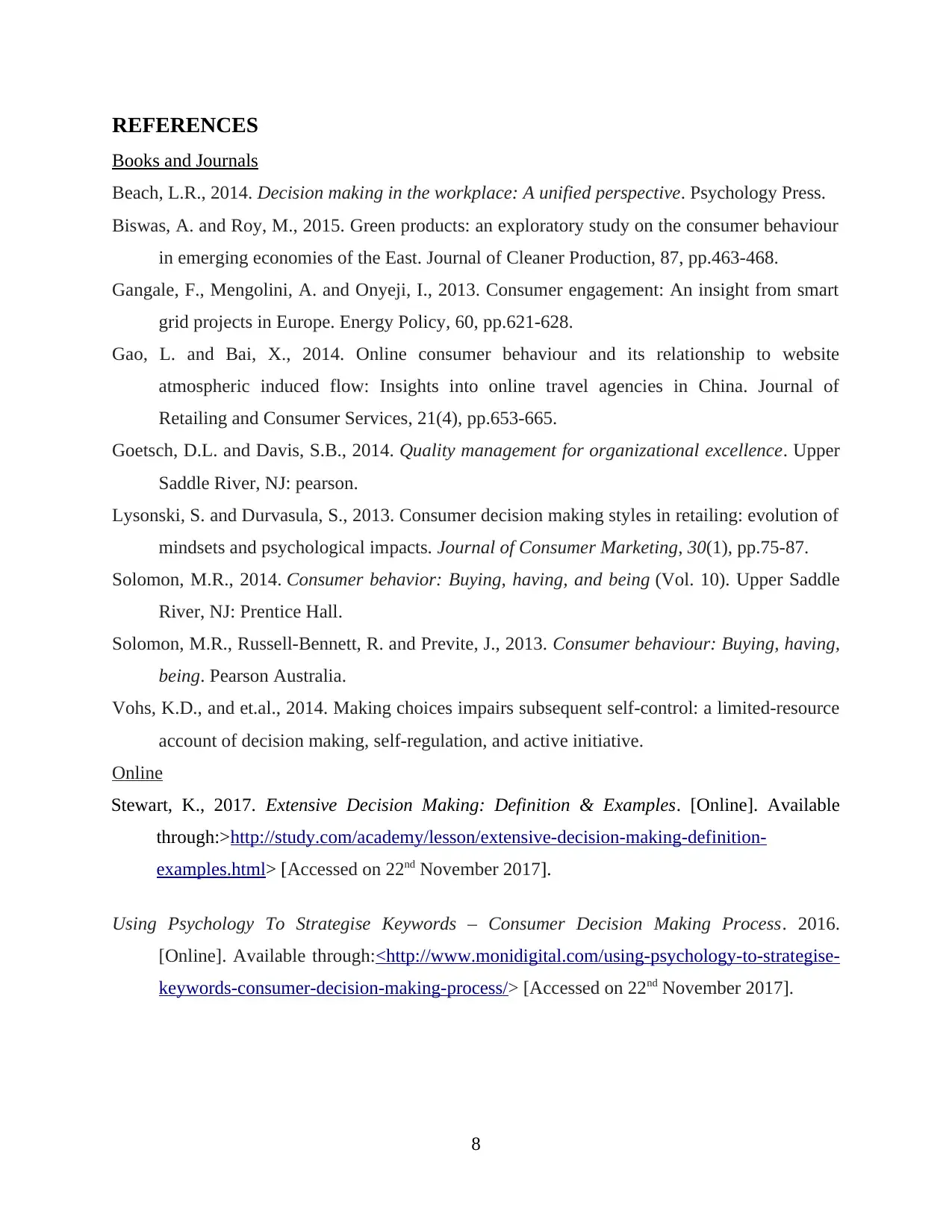
REFERENCES
Books and Journals
Beach, L.R., 2014. Decision making in the workplace: A unified perspective. Psychology Press.
Biswas, A. and Roy, M., 2015. Green products: an exploratory study on the consumer behaviour
in emerging economies of the East. Journal of Cleaner Production, 87, pp.463-468.
Gangale, F., Mengolini, A. and Onyeji, I., 2013. Consumer engagement: An insight from smart
grid projects in Europe. Energy Policy, 60, pp.621-628.
Gao, L. and Bai, X., 2014. Online consumer behaviour and its relationship to website
atmospheric induced flow: Insights into online travel agencies in China. Journal of
Retailing and Consumer Services, 21(4), pp.653-665.
Goetsch, D.L. and Davis, S.B., 2014. Quality management for organizational excellence. Upper
Saddle River, NJ: pearson.
Lysonski, S. and Durvasula, S., 2013. Consumer decision making styles in retailing: evolution of
mindsets and psychological impacts. Journal of Consumer Marketing, 30(1), pp.75-87.
Solomon, M.R., 2014. Consumer behavior: Buying, having, and being (Vol. 10). Upper Saddle
River, NJ: Prentice Hall.
Solomon, M.R., Russell-Bennett, R. and Previte, J., 2013. Consumer behaviour: Buying, having,
being. Pearson Australia.
Vohs, K.D., and et.al., 2014. Making choices impairs subsequent self-control: a limited-resource
account of decision making, self-regulation, and active initiative.
Online
Stewart, K., 2017. Extensive Decision Making: Definition & Examples. [Online]. Available
through:>http://study.com/academy/lesson/extensive-decision-making-definition-
examples.html> [Accessed on 22nd November 2017].
Using Psychology To Strategise Keywords – Consumer Decision Making Process. 2016.
[Online]. Available through:<http://www.monidigital.com/using-psychology-to-strategise-
keywords-consumer-decision-making-process/> [Accessed on 22nd November 2017].
8
Books and Journals
Beach, L.R., 2014. Decision making in the workplace: A unified perspective. Psychology Press.
Biswas, A. and Roy, M., 2015. Green products: an exploratory study on the consumer behaviour
in emerging economies of the East. Journal of Cleaner Production, 87, pp.463-468.
Gangale, F., Mengolini, A. and Onyeji, I., 2013. Consumer engagement: An insight from smart
grid projects in Europe. Energy Policy, 60, pp.621-628.
Gao, L. and Bai, X., 2014. Online consumer behaviour and its relationship to website
atmospheric induced flow: Insights into online travel agencies in China. Journal of
Retailing and Consumer Services, 21(4), pp.653-665.
Goetsch, D.L. and Davis, S.B., 2014. Quality management for organizational excellence. Upper
Saddle River, NJ: pearson.
Lysonski, S. and Durvasula, S., 2013. Consumer decision making styles in retailing: evolution of
mindsets and psychological impacts. Journal of Consumer Marketing, 30(1), pp.75-87.
Solomon, M.R., 2014. Consumer behavior: Buying, having, and being (Vol. 10). Upper Saddle
River, NJ: Prentice Hall.
Solomon, M.R., Russell-Bennett, R. and Previte, J., 2013. Consumer behaviour: Buying, having,
being. Pearson Australia.
Vohs, K.D., and et.al., 2014. Making choices impairs subsequent self-control: a limited-resource
account of decision making, self-regulation, and active initiative.
Online
Stewart, K., 2017. Extensive Decision Making: Definition & Examples. [Online]. Available
through:>http://study.com/academy/lesson/extensive-decision-making-definition-
examples.html> [Accessed on 22nd November 2017].
Using Psychology To Strategise Keywords – Consumer Decision Making Process. 2016.
[Online]. Available through:<http://www.monidigital.com/using-psychology-to-strategise-
keywords-consumer-decision-making-process/> [Accessed on 22nd November 2017].
8
Paraphrase This Document
Need a fresh take? Get an instant paraphrase of this document with our AI Paraphraser

9
1 out of 11
Related Documents
Your All-in-One AI-Powered Toolkit for Academic Success.
+13062052269
info@desklib.com
Available 24*7 on WhatsApp / Email
![[object Object]](/_next/static/media/star-bottom.7253800d.svg)
Unlock your academic potential
Copyright © 2020–2025 A2Z Services. All Rights Reserved. Developed and managed by ZUCOL.





